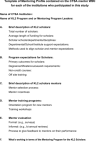Survey of mentoring programs for KL2 scholars
- PMID: 21207765
- PMCID: PMC3159422
- DOI: 10.1111/j.1752-8062.2010.00237.x
Survey of mentoring programs for KL2 scholars
Abstract
There is limited information on how academic institutions support effective mentoring practices for new investigators. A national semistructured telephone interview was conducted to assess current “state of the art” mentoring practices for KL2 scholars among the 46 institutions participating in the Clinical Translational Science Awards (CTSA) Consortium. Mentoring practices examined included: mentor selection, articulating and aligning expectations, assessing the mentoring relationship, and mentor training. Telephone interviews were conducted in winter/fall 2009, with 100% of the CTSAs funded (n=46) through 2009, participating in the survey. Primary findings include: fi ve programs selected mentors for K scholars, 14 programs used mentor contracts to define expectations, 16 programs reported formal mentor evaluation, 10 offered financial incentives to mentors, and 13 offered formal mentoring training. The interviews found considerable variation in mentoring practices for training new investigators among the 46 CTSAs. There was also limited consensus on“what works” and what are the core elements of “effective mentoring practices. Empirical research is needed to help research leaders decide on where and how to place resources related to mentoring
Figures
Comment on
-
In the jungle.Clin Transl Sci. 2010 Dec;3(6):267. doi: 10.1111/j.1752-8062.2010.00241.x. Clin Transl Sci. 2010. PMID: 21167001 Free PMC article. No abstract available.
References
-
- Merchant C. Mentored Clinical Research Scholar (K12) Page. Available athttp://www.ncrr.nih.gov/clinical_research_resources/resource_directory/c....Accessed 9.15.2010.
-
- Kram KE. Mentoring at Work: Developmental Relationships in Organizational Life. Glenview , IL : Scott Foresman; 1985.
-
- Bland CJ, Taylor AL, Shollen SL, Weber‐Main AM, Mulcahy PA. Faculty Success Though Mentoring: A Guide for Mentors, Mentees, and Leaders. New York : Rowman & Littlefield; 2010.
-
- Pololi LH, Knight SM, Dennis K, Frankel RM. Helping medical school faculty realize their dreams: an innovative, collaborative mentoring program. Acad Med. 2002; 77(5): 377–384. - PubMed
Publication types
MeSH terms
Grants and funding
LinkOut - more resources
Full Text Sources
Miscellaneous



